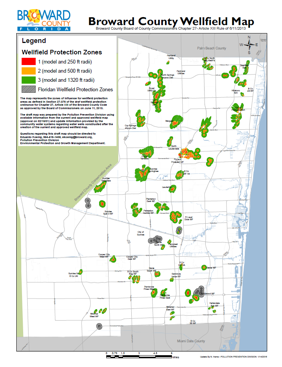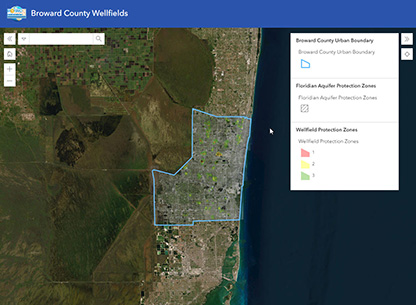As the population of Broward County continues to grow, so does the use of hazardous chemicals and the potential for contamination of our drinking water supplies. Toxic chemicals from chemical spills can persist for a long time underground and they can travel great distances in the subsurface environment to our public potable water wells.
Our main water supplies are dependent on a rain-driven system which recharges the highly transmissive Biscayne Aquifer providing water to supply wells found in Broward County wellfields. The treated water is distributed by public and private utilities to Broward County residents, visitors, and businesses. We recognize that every Broward County resident has a right to drink clean water and that Broward County's potable water source is both a sustainable natural resource and economic asset.
Broward County Wellfield Protection Program
This program establishes protected areas around public and private wellfields. The program’s responsibility is to regulate the storage, handling, use, and production of regulated substances at facilities within the wellfield protected areas. The program’s mission is to prevent hazardous chemicals from being released into the environment where the chemicals can migrate into our potable water supply.
The Wellfield Protection Program has existed since 1984 and is currently in the Environmental Permitting Division (EPD).
The program's goals are to:
- Identify, conserve and protect all recharge areas in wellfield zones 1 and 2 from the introduction and misuse of regulated substances. The team's primary focus is on pollution prevention and control and maintaining and enforcing a licensing, inspecting and monitoring program to abate potential threats from regulated substances to the ground water.
- Protect the quality of Broward County's potable water supply and minimize the presence of all regulated substances in wellfield protection zones by continuing to implement and improve Chapter 27, Article XIII, Wellfield Protection, Broward County Code of Ordinances which regulates the storage, handling, usage, disposal or production of regulated substances within designated zones of influence.
- Conduct inspections of facilities in wellfield protection areas to locate possible contamination sources and insure abatement of identified sources.
- Foster a solid working relationship with the public utilities and the regulated community.
- Implement the division's enforcement strategy program, geared toward the early identification of environmental problems/issues and to focus on inspecting those facilities that pose the most significant potential to cause environmental harm due to noncompliance or mismanagement.
Broward County has one of the safest drinking water supplies in the world. We are fortunate that we have been able to maintain a safe water supply in a county with numerous facilities that store, handle, use and manufacture hazardous materials. As the use of hazardous chemicals in Broward County continues to grow, the potential for contamination of our water supplies will increase. Although our water supplies are safe now, we cannot afford to lower our commitment to protecting this vital resource.
The Wellfield Protection Program performs an integral part in the Environmental Permitting Division's mission. This includes an extensive inspection, pollution prevention promotion and monitoring program at each hazardous material facility and a monitoring program of the potable water quality. This is being done to ensure that chemicals at hazardous materials facilities are not impacting the public water supply. This is done because the most cost-effective and time-effective approach to protecting our wellfields is to prevent contamination of the water supply before it occurs.
All existing anthropogenic and natural sources are inventoried within the protected areas. Contaminant sources that can threaten the drinking water supply are numerous and may include non-point source pesticide and herbicide impacts, point source impacts such as underground storage tanks, domestic septic tanks and abandoned and improperly constructed wells. The sources are evaluated based on the potential to cause human health and environmental risks. Current inventories of facilities using, storing or producing hazardous materials are maintained and these facilities are routinely inspected to ensure compliance with their Hazardous Material Facility Management Licenses. Pollution prevention practices are promoted during the inspections.
Wellfield protection requires the participation of all levels of government. The team continues to improve its wellfield protection efforts by defining the roles and duties of the participating entities at all levels of government, delineating wellhead protection areas, identifying and monitoring all sources of contamination in the protected areas; and ensuring the program's success by encouraging public participation and promoting public education.
Federal & State Wellfield Protection Programs
Both the Federal Government and the State of Florida have programs directed toward protecting sources of public drinking water.
The Federal program is administered by the Environmental Protection Agency (EPA) from Washington, D.C. and their Region IV offices in Atlanta, Georgia. The web site for the EPA is
www.epa.gov/. Another web site for drinking water information is www.epa.gov/safewater/.
The State of Florida program is administered by the Florida Department of Environmental Protection (FDEP) from Tallahassee, Florida and West Palm Beach, Florida. The web site for the FDEP is
www.dep.state.fl.us/. Other web sites for drinking water information are
www.dep.state.fl.us/swapp/ and
www.dep.state.fl.us/water/drinkingwater/index.htm.
Hazardous Material Management Facility License
If your business is located within Zone 1 or Zone 2, you may need to
apply for a Hazardous Material Management Facility License. Before applying, examine the product labels and Material Safety Data Sheets for each chemical at your business. Compare the chemicals to this list of regulated substances. The license requires recordkeeping, notifications, training, ground water and raw water monitoring, a spill prevention and control plan and is subject to criteria for monitoring well installation and sampling.
Several of the chemicals on the list of regulated substances cover a broad range of chemicals such as “Petroleum products which are hazardous or toxic.” A substantial number of chemicals fall within that category. If you have additional questions call 954-519-1483 for further information.
If your business is located within Zone 3, you may need to
apply for a Hazardous Material Management Facility License. You may need the license if you have had a discharge of chemicals that contain regulated substances at your facility.
If your business is located in Zone 1, Zone 2 or Zone 3 and you do not store, handle, use or produce regulated substances but you do store 25 or more gallons of hazardous materials, you may be required to apply for a Hazardous Material Management Facility License.
To obtain a license application you can download a copy of the
application from this web site or you can call our offices at 954-519-1483 for an application.
Help Protect Our Public Wellfields
Chemicals improperly used on your property could pose a risk to the public drinking water supply.
There are several ways that you can protect the public wellfields.
- Do not spill chemicals onto the ground, into the surface waters or into storm drains.
- Follow the manufacturer's instructions when using chemicals. Fertilizers, pesticides and herbicides should be applied no more than the concentration and frequency recommended by the manufacturer.
- Dispose of household hazardous waste at hazardous waste collection centers. The Office of Solid Waste and Recycling (954-765-4999) has information about hazardous waste collection programs.
- Report the improper use, storage and handling of hazardous chemicals to the department's hotline at 954-519-1499.
Some substances that contain hazardous chemicals include pesticides, herbicides, fertilizers, automotive fluids and paints. Also, please notify any pest control or lawn services that you employ to take special care when they apply chemicals to your property.
The Hazardous Material Facility Management License will contain general conditions and wellfield specific conditions.
The general conditions are found on all Hazardous Material Facility Management Licenses. The wellfield specific conditions are prepared specific to the facility's inventory, location within the wellfield protected area and type of business. The license will contain a minimum of eight wellfield conditions. Licenses for water treatment plants, multi-tenant facilities or facilities that have obtained a variance will have additional conditions. This summary of wellfield general and specific conditions provides a general description of the typical license conditions.
Map of Wellfield Zones
In order to determine whether your business is in a wellfield zone of influence you need to examine the wellfield protection map to see if your business is in Zone 1 (area inside the red line) or Zone 2 (area between the red and yellow lines) or Zone 3 (area between the yellow and green lines). An area outside of the green line is outside the wellfield zones of influence. The map on this web site can be magnified for more detail. If you are unable to make this determination, call
954-519-1406 for further information.
Official Map of Wellfield Zones
-
Zone 1 means the wellfield protection area shown on the zones of influence map approved on February 16, 2001 for water wells included on that map, and within 250 feet from an existing water well for wells not included on that map.
-
Zone 2 means the wellfield protection area shown on the zones of influence map approved on February 16, 2001 for water wells included on that map, and situated between the outer boundary of Zone 1 and 500 feet from an existing water well for wells not included on that map.
-
Zone 3 means the wellfield protection area shown on the zones of influence map approved on February 16, 2001 for water wells included on that map, and situated between the outer boundary of Zone 2 and 1320 feet from an existing water well for wells not included on that map.
Click for Wellfield PDF Map Click to access interactive wellfield map.


